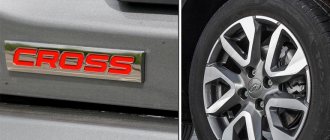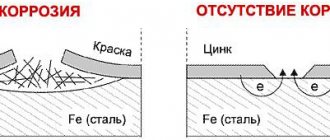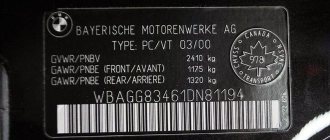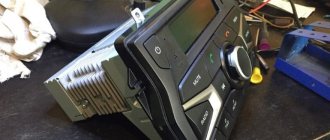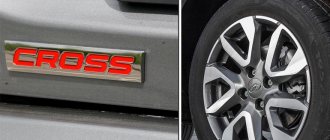When purchasing any new car at a car dealership, the future owner is given additional literature along with a set of documents, which must include an instruction manual. This is a brochure that describes all the main points about the car - from the assignment of different buttons in the cabin to the selection of the right consumables for undergoing maintenance. But there are cases when this book is lost or simply not at hand. This often happens when buying a used Lada Vesta SV Cross. Then our website will come to the rescue. We invite you to download the Lada Vesta SV instruction manual simply by clicking on the link below:
Operating manual Lada Vesta SV (Size 3.7 MB Edition 12/21/2017)
This manual is universal and can be applied to the Lada Vesta SV station wagon in any configuration.
Service book: what is it?
For a car, it plays the same role as a medical card for a person: it collects information about a person’s medical history (data about visits to the hospital, all “diseases,” medical examinations). Warranty information is recorded in the service book, starting from the sale of the car.
The first pages welcome the owner of Vesta, inform him of his rights in relation to the seller, and briefly describe the essence of the car warranty. Next, the page is devoted to confirming the pre-sale preparation of the car - that is, the car dealer signs the statement that the car is fully operational and ready for sale.
Several pages are reserved for warranty repairs - “tickets” for warranty repairs based on the owner’s claim are divided separately, indicating:
- mileage;
- number of the warranty service certificate;
- city and name of the company that carried out the repairs;
- list of replaced or repaired components and assemblies;
- company seal.
Remember that warranty repairs may be refused - do not leave the service without the appropriate mark. If it turns out that the malfunction falls under the warranty conditions, you will have confirmation that you have already applied, but received a refusal to claim.
Finally, inspection tickets are given to inspect the paint and varnish coating (for damage and defects). The compilers of the book kindly provided a directory with addresses and telephone numbers of all service stations that will help in completing the “official” repair.
What is “zero maintenance”
Zero maintenance is a type of maintenance that is carried out after 2500-3000 km. For some cars of the Lada TO-0 line, this is a mandatory measure, but Vesta is not included in their list. However, for her such a check would be quite appropriate.
TO-0 Lada Vesta usually includes:
- changing oil and filter;
- checking for extraneous noises and sounds;
- checking the smoothness of gear shifting;
- checking wheel alignment angles;
- checking the main systems;
- checking the operation of the headlights and adjusting them (if necessary).
The total cost including consumables can reach RUB 3,000. The car dealership should not make a note in the service book, because there is not even a column for this type of service.
Self-service
Since the three-year warranty period had ended, we saw no reason to overpay the dealer for work if we had our own technical center in Tushino. And the consumables purchased at a regular spare parts store made the pockets lighter to a minimum. A canister of “synthetics” Lada Ultra 5W40 (1187 rubles), oil (193 rubles), air (255 rubles) and carbon cabin filters (334 rubles) - that’s the entire set required. Total - less than 2000 rubles for everything. An official TO-5 dealer would cost about 7,000 rubles.
Almost immediately after the purchase, Vesta was equipped with hood and trunk shock absorbers. The first are alive, the second gave up after one winter. And last winter they also began to creak disgustingly. I took it off and threw it away without any regrets.
Almost immediately after the purchase, Vesta was equipped with hood and trunk shock absorbers. The first are alive, the second gave up after one winter. And last winter they also began to creak disgustingly. I took it off and threw it away without any regrets.
↑ First maintenance, 15,000 km
The first maintenance after 15,000 km of mileage or 1 year of operation after purchase is carried out in certified centers that have an agreement with official dealers. From this moment on, all work performed is noted in the service book. It contains the necessary list of such works. The car owner needs to check their volume and quality in a timely manner.
Attention! Provided the zero maintenance cycle is completed, there will be fewer problems with maintenance-1.
The required scope of work during the initial inspection includes:
- changing the oil and filter, cabin air filter, drive belt;
- checking the tightness and level in the cooling system and fuel system;
- condition of brake pads, steering, front and rear suspension;
- operation of the generator, windshield wiper, heated seats, heated rear window, climate control system;
- checking the health of the battery (amount of electrolyte and charge density);
- serviceability of electric windows, mirrors, door locks
- drainage system.
Thus, all major vehicle systems are subject to diagnostics:
- steering;
- chassis;
- brake system;
- transmission;
- accumulator battery;
- electrical equipment;
- tightness of hoses and connections;
- locks.
The car body is checked for corrosion and chips. In operating mode, the engine and gearbox are listened to to determine uncharacteristic noises and knocks.
Detected deviations are eliminated with a corresponding note in the service book.
Nuances about the warranty for Lada Vesta
Many people are mistaken and think that AvtoVAZ gives a guarantee of 3 years of operation or 100 thousand km. I drive a Lada Vesta, so I will talk about AvtoVAZ. People think that you can drive 100 thousand and not worry. But that's not true. If you think that if you have a knock somewhere and the dealer will immediately replace the spare part for you, then you are mistaken. Therefore, I decided to find out how long the warranty for Vesta is. The timing belt pulley on my car flew off and started making noise. So I re-read the warranty card and found out that the warranty period for it is zero. Below I’ll explain what’s going on. I called the dealership and asked if this roller was covered under warranty. They said no.
Some advisers say that the timing belt can become stiff in the cold and make such sounds. But the temperature outside is above zero. Even when I drove in severe frost, the belt did not make any sounds.
↑ Third maintenance, mileage 45,000 km
TO-3 the car must pass through 45,000 km. The cycle repeats the first technical inspection.
The same amount of work is performed:
- Change of oil;
- air filter;
- cooling system inspection;
- brake system;
- wheel condition;
- pendants;
- transmissions;
- batteries;
- electrical equipment;
- drainage system.
This order is determined by the degree of wear of machine parts and mechanisms. At the same period of time or mileage, it is necessary to replace the brake fluid in the system.
↑ Vesta maintenance cost
You can find out the price of service on the AvtoVAZ website. For 4 modifications of Lada Vesta it has the same cost for different maintenance cycles. An exception to the price is the CNG model, a car that has two engines (petrol and gas).
For SW CROSS, SW, CROSS, sedan, regardless of engine size, the cost will be (thousand rubles):
- for the first maintenance – 5.4;
- for the second – 7.5;
- for the third – 5.4;
- for the fourth – 7.5;
- for 5 – 5.4;
- for 6 – 14.6.
CNG maintenance costs (thousand rubles):
- at the first maintenance – 10.8;
- the second – 12.8;
- third – 10.8;
- fourth – 12.8;
- fifth – 10.8;
- sixth – 20, 361,
Manufacturing defects are corrected free of charge, such as a windshield scratched by windshield wipers. All other costs caused by the operation of the car, for example, adding brake fluid, replacing brake pads, are paid by the car owner.
↑ Decoding of Vesta maintenance
Maintenance and repair of the Lada Vesta is necessary to maintain the operational characteristics of the car in working condition in order to avoid emergency situations.
Attention! Maintenance involves carrying out routine (mandatory) and diagnostic (control and testing) work with the replacement of spare parts and consumables that comply with the regulations.
The warranty period for Lada Vesta is 6 years or 100,000 km (either age or mileage). During this period, the machine will go through a full cycle of warranty service, during which defects caused by the manufacturer will be eliminated. In addition, any detected faults caused by the operation of the vehicle will be repaired.
The overhaul period is 1 year or mileage 15,000 km. For this period, a service book is issued, where notes are made about identified defects, breakdowns, and failures.
Starting from 105,000 km or Vesta’s age of 7 years, maintenance repeats the entire previous cycle at the expense of the car owner.
Similar products
The Legion-Avtodata Internet portal was created for convenient purchases: auto literature, programs for car diagnostics, diagnostic instruments, elm327 adapters, auto accessories and tools for auto repair. You can buy books and equipment for diagnosing and repairing a car in our online store. It is convenient to pay for repair and operating manuals for your chosen car brands using any of the payment systems. Order delivery of a car book by mail without prepayment, by courier in Moscow, regions and to more than 200 pick-up points throughout Russia.
Collection of technological instructions Lada Vesta
The article presents manuals for the maintenance and repair of the Lada Vesta car. The collection of instructions is intended for specialists and engineering and technical workers of enterprises involved in the sale, maintenance and repair of LADA vehicles, and can be used in personnel training.
Automated manual transmission control system for Lada Vesta cars - fault diagnosis
Emergency response system for Lada Vesta car accidents - design and fault diagnosis
Airbag system for Lada Vesta cars - design and fault diagnosis
Automatic climate control system for Lada Vesta cars - fault diagnosis
The control system of the continuously variable transmission (CVT) “jatco” of the Lada XRAY car – device, principle of operation, diagnostics
Instrument cluster of Lada Vesta cars - fault diagnosis
Upholstery
I praise the upholstery. Vesta is a budget car, and 78,000 km can be called serious mileage. The “leather” interiors of other foreign cars that are not the cheapest look depressing for such mileage. Lada's fabric is in order! She practically didn’t stretch out on the driver’s seat cushion (in the Almera, for example, the picture was worse). The central armrest, on which I constantly lean, does not show any traces of use.
And the interior trim is not easily soiled. I have three dogs, and although I carry them in the back seat in a special hammock, the sides of the sofa and the door panels cannot be completely covered. So there are no stains on them. For three and a half years I did without stain remover, using a simple vacuum cleaner.
The fabric on the driver's seat barely stretched. For a budget employee with such mileage and a driver weighing over 90 kg, I think this is a good indicator.
The fabric on the driver's seat barely stretched. For a budget employee with such mileage and a driver weighing over 90 kg, I think this is a good indicator.
Vesta's interior fabric is nice and non-staining. The edges of the seat that are not covered with a dog cape do not require dry cleaning. Even those that are light gray in color.
Vesta's interior fabric is nice and non-staining. The edges of the seat that are not covered with a dog cape do not require dry cleaning. Even those that are light gray in color.
↑ Replacements according to service life
The manufacturer recommends that car owners replace parts and consumables that are subject to the greatest impact every 15,000 km.
When using the machine in difficult conditions, the procedure must be carried out after 10,000 km or 7,500 km.
Unfavorable factors include:
- operating a car in a metropolis, when you have to travel short distances;
- driving in traffic jams at low speeds;
- driving on country roads when there is a lot of dust;
- moving a trailer or with a maximum load.
When you first call for service, the engine oil, oil filter, cabin air filter, and alternator drive belt will be replaced.
Replacing consumables during the second maintenance includes 6 items, of which 4 are mandatory and 3 are necessary. Their cost, replacement, installation are paid additionally.
This includes: engine oil, engine air and oil filters, spark plugs, cabin heater filter. Working fluids are added as needed and the front and rear brake pads are changed.
The third time you contact the technical service center, the following must be replaced:
- motor lubricant;
- oil filter;
- filter element of the cabin heating system.
Brake pads are replaced as needed, working fluids and freon are added.
At the fourth maintenance they change:
- engine oil;
- oil filter;
- engine air filter;
- candles;
- cabin heating filter.
Consumable fluids are added as needed and the front and rear brake pads are changed.
The fifth service cycle is identical to the third in all respects, including operational replacements.
TO-6. In this case, it is necessary to replace the components of the brake, fuel, and cooling systems: brake fluid, coolant, oil. The spark plugs, suspension belt, air and cabin filters, alternator belt and tension pulley are replaced. If necessary, freon is added to the air conditioning system and the brake pads are replaced.
All subsequent replacements coincide in cycles.
Attention! The exception is TO-12, on which the timing belt is changed.
Maintenance records
In total, the Lada Vesta service book contains 12 maintenance coupons:
- Mileage 14,500 – 15,500 km, or after 1 year of operation;
- Mileage 29,500 – 30,500 km, or 1 year of operation after the previous maintenance;
- Mileage 44,500 – 45,500 km, or 1 year of operation after the previous maintenance;
- Mileage 59,500 – 60,500 km, possible after 1 year of operation after the previous maintenance;
- Mileage 74,500 – 75,500 km, or 1 year of operation after the previous maintenance;
- Mileage 89,500 – 90,500 km, possible after 1 year of operation after the previous maintenance;
- Mileage 104,500 – 105,500 km, or 1 year of operation after the previous maintenance;
- Mileage 199,500 – 120,500 km or 1 year of operation after the previous maintenance;
- Mileage 134,500 – 135,500 km, possible after 1 year of operation after the previous maintenance;
- Mileage 149,500 – 150,500 km or 1 year of operation after the previous maintenance;
- Mileage 164,500 – 165,500 km, or 1 year of operation after the previous maintenance;
- Mileage 179,500 – 180,500 km or 1 year of operation after the previous maintenance.
During each visit, the master will do:
- Diagnostic inspection work, during which the chassis, tires and wheels, steering play, power steering, headlights, battery, etc. will be checked at 18 points;
- Routine work (they consist of replacing technical fluids (brake, oil, etc.), replacing consumables (filters, timing belt, crankshaft, camshaft pulleys).
What does TO-2 and subsequent maintenance include?
The next maintenance should be carried out every 15,000 km or a year after the previous maintenance - whichever comes first. Thus, TO-2 is 30,000 km or 2 years of driving, TO-3 is 45,000 km or 3 years of driving, etc.
The second maintenance of Lada Vesta, in addition to all routine maintenance of TO-1, includes the following procedures:
- replacing the air filter and spark plugs;
- lubrication of door hinges, rubbing areas of door opening limiters, hinges and springs of the fuel tank hatch, door keyholes and trunk lid;
- cleaning and lubricating battery terminals and clamps.
Taking this into account, the cost of a TO-2 Lada Vesta will be more than 7,000 rubles. But TO-3 repeats the work of the first one and its price will be corresponding.
Maintenance of Lada Vesta
↑ What problems are most often identified on Lada Vesta
The detected defects largely depend on the mileage of the car.
At 3000 km it could be:
- scratches on the windshield and side windows;
- peeling paint on the front and rear bumpers;
- erasing the paint on the steering wheel cover;
- failure of discs when driving on uneven roads;
- creaking hinges of door locks;
- dirt in the engine compartment in the lock area due to lack of seal.
At 15,000 km, problems are most often found in the chassis, cooling, heating, corrosion and scratches. Regarding the ball joints, this is play in the lower pairs. The rear stabilizer struts make a knocking sound, and the rubber bushings make a squeaking sound. The cooling system pipes fail. The heated windshield does not function. Corrosion on the side mirrors, on the resonator housing. The multimedia system does not work properly.
Damage to glass. The cause of scratches is hard wipers and excessive compaction of the side windows, which become abrasive when contaminated with sand.
At 20,000 km, the door limit switches may fail. The rubber bands holding the muffler sag and break.
After a run of 30,000 km, errors appear in the operation of the gearbox, both automatic and manual transmission. Problems with ball joints that did not occur previously may appear now. The creaking of plastic can be heard in the cabin. When the heater fan operates at high speeds, the steering wheel begins to vibrate. The trim on the rear doors is starting to come off.
The listed shortcomings are not serious defects. They can be easily removed by the car owner himself or at a car service for little money. AvtoVAZ monitors and eliminates typical defects by changing suppliers or technology.
The editorial sedan underwent the fifth maintenance in its life. We refused the services of the official service and switched to servicing the car ourselves. The regulations are strictly followed, but going on a long journey while driving a Vesta is still a little scary.
LADA > Vesta
More than once I had to read and listen to reproaches: why don’t we run more intensively on Vesta?
This model even now, three and a half years after its launch into the series, does not lose its relevance and is of great interest.
But here’s the problem: there are no conditions for long runs yet. A couple of vacations a year add mileage, but not globally. And even if I hadn’t switched to a motorcycle for the summer, editorial Vesta still wouldn’t be striking with the numbers on the odometer now. Therefore, Vesta has only undergone five maintenance tests so far.
What to look for when choosing
Choosing a car that is no more than 4 years old (there are simply too few five-year olds) does not promise to be very difficult in terms of weeding out bad options.
Typical features such as rust and rot in hidden cavities, a hundred to two thousand kilometers of mileage, and duplicate vehicle registration certificates are still ahead of Vesta. Now the task seems simple: find a car without an accident history, with an honest service history and correct mileage. The only thing you need to decide in advance is which power unit and body type you need in order to calculate your budget. At the time of launch, Vesta’s engine range had one engine - a 1.6-liter 106-horsepower 21129. An alternative in the form of a 1.8-liter engine 21179 arrived a year later - at the end of 2020. This unit produces 122 hp. developed on the same technical basis while maintaining the same block and cylinder diameter. The increase in volume was achieved by lengthening the piston stroke with accompanying modifications to the cooling and lubrication systems.
The main complaint about the 1.8-liter engine was the tendency to burn oil - at VAZ the problem was explained by defective components, and over time the relevance of the issue decreased. The line was replenished with a third engine last year: the French H4M with 1.6 liters and 113 hp. appeared under the hood of Vesta along with a CVT.
Last year, the variator itself replaced the long-suffering robotic gearbox, developed on the basis of VAZ mechanics, from the transmission range. Early AMT models received a lot of complaints about illogical operation, slow shifts, clutch wear and other minor and not so minor shortcomings, not to mention features like the inability to start up a hill without pressing the gas.
Over the years of production, the box was constantly improved and a “crawling” mode and more efficient manual control were added to it, but the consumer voted with rubles, and the vote was not in favor of AMT. The conventional five-speed manual was simpler and more familiar, even after the transition in 2022 from the French JH3 to the domestic 21807, which is somewhat noisier.
Novaya Lada: Foreign companies and their branches - West Concept
In 2022, the list of available body types was expanded: in addition to the sedan, a station wagon appeared in two versions, regular and crossover. So if you definitely want to buy a station wagon, you should prepare more money - firstly, because of the age of the cars, and secondly, because station wagons themselves have always cost more than a sedan.
An important factor in favor of choosing Vesta is its decent reliability. You won’t have to spend a large amount of money on maintenance and repairs after purchase: the VAZ bestseller fully lived up to the expectations placed on it.
